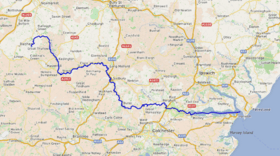River Stour, Suffolk facts for kids
Quick facts for kids River Stour |
|
|---|---|

The Stour at Manningtree, Essex
|
|

Course of the Stour river.
|
|
| Country | England |
| Counties | Cambridgeshire, Suffolk, Essex |
| Cities | Haverhill, Sudbury, Harwich |
| Physical characteristics | |
| Main source | West Wickham, Cambridgeshire, UK 117 m (384 ft) 52°07′34″N 0°22′42″E / 52.1261°N 0.3783°E |
| River mouth | North Sea Harwich, Essex, UK 0 m (0 ft) 51°56′58″N 1°13′11″E / 51.9494°N 1.2196°E |
| Length | 47 mi (76 km) |
| Basin features | |
| Tributaries |
|
The River Stour is a famous river in East Anglia, England. It is about 47 miles (76 km) long. This river forms most of the border between Suffolk (to the north) and Essex (to the south).
The Stour starts in eastern Cambridgeshire. It flows past towns like Haverhill, Cavendish, Bures, Sudbury, Nayland, Stratford St Mary, and Dedham. The river also goes through the beautiful Dedham Vale Area of Outstanding Natural Beauty. Near Manningtree in Essex, the river becomes tidal, meaning its water level changes with the ocean tides. Finally, it joins the North Sea at Harwich.
Contents
What's in a Name? The River Stour's Story
The name Stour is a bit of a mystery. No one is completely sure where it comes from.
One idea is that the name Stour comes from an old Celtic word, sturr, which means "strong." However, it's interesting that this river name is common in England but not found in Wales. There are also rivers called Stura near Turin, Italy, and a river called Stoer in Germany.
People even say the name Stour differently depending on where you are. The Stours in Kent and East Anglia (like this one) often rhyme with "tour." But the Stour in Oxfordshire might rhyme with "mower" or "hour." In the area where this River Stour flows, people say it differently too, sometimes like "stowr" and sometimes like "stoor."
Some old English words also used "stour." As an adjective, it meant "large" or "powerful." As a noun, it could mean "a big fuss" or "a fight." It's possible that the different Stour rivers don't all have the same origin for their names.
Exploring the River Stour
The River Stour begins in Wratting Common, Cambridgeshire, near Weston Colville. It then flows all the way to the sea at Harwich. A large part of the eastern River Stour is a special area called the Dedham Vale Area of Outstanding Natural Beauty (AONB). This area is named after the village of Dedham in Essex. It's a very beautiful countryside area on both sides of the river. The Dedham Vale AONB is about 11.5 miles (18.5 km) long and 2.4 to 4.8 miles (3.9 to 7.7 km) wide.
The earliest known human settlement along the river in Suffolk was at Great Bradley. People have lived there for over 5,000 years!
The River Stour was one of the first rivers in England to be made easier for boats to travel on. In 1705, a special law was passed. This law allowed the river to be used for public navigation from Manningtree to Sudbury. A group of investors from London and Suffolk raised money to make the river better for boats.
Even after railways became popular, special boats called lighters were still used on the Stour. They carried goods almost until World War II. Even today, lighters still operate as far as Mistley.
Artists and the Stour Valley
The Stour valley has been a source of inspiration for many famous artists. Painters like John Constable, Thomas Gainsborough, Alfred Munnings, John Nash, and Cedric Morris have shown the working river in their art.
John Constable had a very strong connection to this area. You can see this in his paintings, such as The Stour Valley and Dedham Church from around 1815. Today, much of the Stour valley is still recognized as an Area of Outstanding Beauty. John Nash lived in the Stour valley and is buried in a small, peaceful village called Wormingford.
Protecting the River Stour
The River Stour Trust was started in 1968. This group works to protect and improve the public's right to travel on the River Stour. They want to make it possible for boats to travel all the way from Sudbury to the sea again. They have already successfully fixed locks (water lifts for boats) at Stratford St Mary, Dedham, Flatford, and Great Cornard.
The trust also encourages people to use the river in small boats. They organize fun events every year for people of all ages and skill levels. You can even take boat trips or private tours with the River Stour Trust in Flatford and Sudbury between Easter and October. These trips are led by volunteer boat crews.
The Environment Agency is in charge of managing navigation on the river. Other groups, like the River Stour Boating Community Interest Company and Outdoor Hire Centre Network, also organize activities. They offer two-day canoeing and camping trips from Sudbury to the estuary at Cattawade. They also host annual events like a Santa Paddle and a Coracle Regatta.
The Stour Estuary RSPB reserve is a special nature reserve. It is managed by the Royal Society for the Protection of Birds (RSPB). This reserve helps protect the wildlife that lives around the river's estuary.
River Challenges
In July 2019, parts of the River Stour dried up. This happened because there wasn't much rain, and debris was blocking the water flow at Bures Mill. The Environment Agency had to pump water from underground into the river to try and bring the water levels back up.
Images for kids
-
Boats on the Stour with the church of Dedham in the background, John Constable, c. 1811







